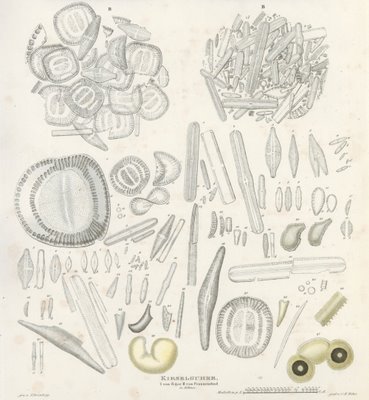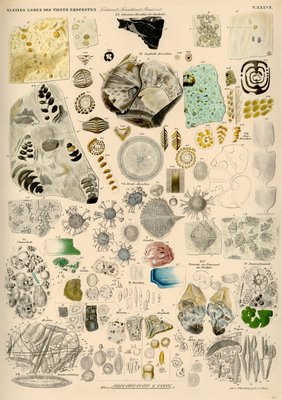
















[click on the images for larger versions]
Christian Gottfried Ehrenberg (1795–1876) from Saxony in Germany, began studies in theology, switched to medicine and he ultimately defended a PhD thesis in mycology. He befriended and accompanied the great Alexander von Humboldt on his Russian expedition and also undertook many of his own scientific excursions, particularly in the Middle East.
Although his central profession revolved around a medical Professorship, his primary interests were the broad areas of study related to microscopy. Ostensibly he had a passion for microorganisms but his enormous collection of plant, animal and soil specimens provided Ehrenberg with a unique opportunity to catalogue a wide range of micro-material for the first time.
Perhaps chief among his many credits, beyond the description of thousands of new unicellular diatoms and radiolaria (Haeckel continued/expanded this work) from the Protist Kingdom, was Ehrlenberg's astonishing report of an immense abundance of microfossils in rock formations. His world wide renown ensured he was plied with geological and organic specimens from all over the globe and I saw mention of many exotic and far flung places in the plates above. Thus did Ehrlenberg establish the scientific field of micropaleontology and he was likewise a pioneer in the geological discipline that came to be known as palynology (study of living and fossilized spores, cysts and associated molecules).
The huge natural bioscience and geological collection amassed by Ehrlenberg is today housed at the Museum für Naturkunde at Humboldt University in Berlin together with a large number of original drawings.
The plates above (from the section 101-140) are from a 2 volume publication by Ehrenberg from 1854 called 'Mikrogeologie'. Venturing into the download section of the Museum für Naturkunde is not for the faint of
- 'Hundredth Year Memorium: Christian Gottfried Ehrenberg 1795-1877' IN: 'Palynology' 2: 209-211 (1978) by W Sarjeant.
- There is an extended commentary, touching on Ehrlenberg's contributions to science and particularly the study of Radiolaria, in a bibliographic appendix to Ernst Haeckel's contribution to the HMS Challenger publications.
- Wikipedia. There's a lot more around online but these all pretty well cover the basics.
- UPDATE: later Ehrenberg posts - highly recommended: The Infinitesmal I AND; The Infinitesmal II AND Minimalism
No comments:
Post a Comment